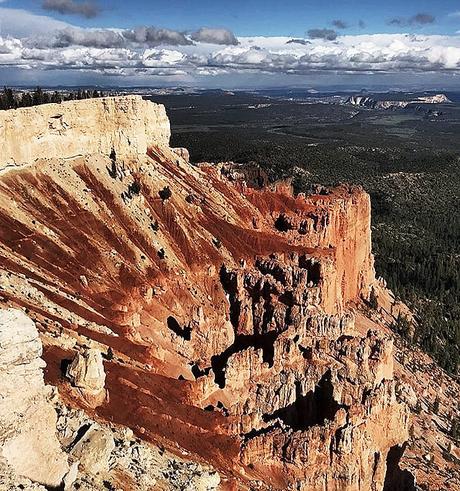Bryce Canyon national Park is located in southwestern Utah and 260 miles from the city of Las Vegas. It is north of the Grand Canyon National Park, about 144.5 miles via US-89 S and US-89A S.
Bryce Canyon is that it is a park suitable for all ages. It can be visited in various ways, hiking, riding a mule or simply visiting the viewpoints from the edge of the amphitheater, where the park offers all the facilities to look out at the most popular points and have beautiful views without much difficulty.

Bryce Canyon is not a canyon per se, as it was not formed by the erosion of a river. It is a great natural setting that has been created on the slopes of the Pausagunt plateau. This plateau is made up of sedimentary rock. That is, sediments that with the passage of millions of years turned into rock. Not being hard rock, it dissolves with erosion (wind and rain, snow)
When the snow season arrives, it melts, the resulting water gets into the fissures of the rock. At night it freezes expanding and breaking the softest rocks.

Summer storms drag loose rocks and as an end result, we have unique
geological structures called hoodoos or fairy chimneys.
The range of colors of this rocky and clay terrain are red, orange, pink, blue, yellow and white.
The colors that can be seen are the result of the oxidation of the materials of which the Bryce Canyon stone is composed. Red and yellow come from iron. The blue and purple of manganese.
While any time of year is a good time to visit Bryce Canyon, spring and fall are two good times as temperatures are milder. In summer, the peak hours of the day must be ruled out due to the high temperatures.
In winter it is difficult to go hiking due to the presence of snow. But a visit to Bryce Canyon in snow is an amazing experience. especially for the contrast of colors between the snow and the colorful rocks of Bryce Canyon. With rain mud forms and it is very difficult to walk the park

Moving around Bryce Canyon National Park
Bryce Canyon is an elongated park that follows the edge of the Paunsaugunt Plateau for 20 miles. From there you can see the natural amphitheatres caused by erosion and rockfalls. The Bryce Anphitheater is the most spectacular and the most visited, in addition to where almost all the trails in the national park depart
The park road is linear, not circular, so the viewpoints are on the left at the edge of the plateau. Bryce Canyon operates a free transportation system with two lines operating from May to early October. They operate from 8 AM to 8 PM. The frequency is 10 to 20 minutes, depending on the time of day.
What to do in Bryce Canyon National Park
The most spectacular point and also the most visited is the Bryce Anphitheater. In that place are the main viewpoints and also the beginning of the most popular trails. These trails are: Sunrise Point, Sunset Point, Bryce Point or Inspiration Point.
Although any time of the day is good to visit the viewpoints, the Bryce Anphitheater must be visited at sunrise. This that this viewpoint is oriented towards the point where the sun rises.
After visiting the viewpoints you can go hiking to the bottom of the canyon. the trails are relatively easy and not very long. The landscapes are amazing.
The access road to Fairyland Point Trailhead is located 1 mile north of the visitor center. This circular route can also be accessed by linking from Sunrise Point. This is the easiest trail to make in Bryce Canyon.
The complete circular route is almost 9 miles, and depending on the physical condition it can be done in 5 hours.

With these two trails a circular route is completed, which has incredible landscapes. Start at Sunrise Point to gently descend between the hoodoos until you reach the bottom of the canyon. Below you can walk through the rock formations that are so unique.
They are 1.8 miles quite easy. until connecting with the Navajo Loop, where the ascent begins by one of its two zig-zags. These are Wall Street or Thors Hammer. Either path has mind-blowing views.
It can also be done in reverse, down the Navajo Loop and linking to the Queens Garden Trail. From there it is easier to ascend, because there is less slope. The tour lasts approximately two to three hours

It is a circular route that is located at the bottom of the Bryce Anphitheater. This tour begins and ends at Bryce Point. It is best to walk it, where the Wall of Windows is located and link to the Navajo Loop or Queens Garden Trail.
There are several viewpoints along the park's main road until you reach Yovimpa Point, which is the last of all. Seeing the main amphitheater, you can go to the Natural Bridge, where there is an almost perfect natural stone arch.
Click on Pic for Download map ( NPS Official map)
For More info on National Park Service National Park bryce Canyon Official Site

